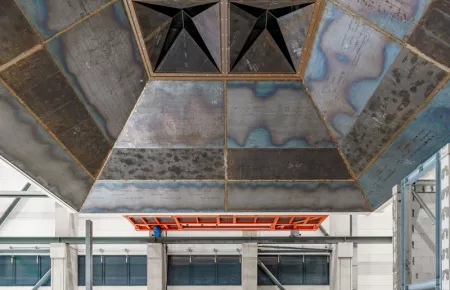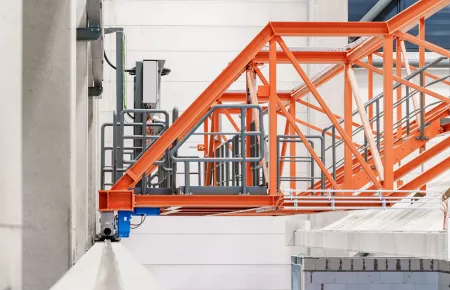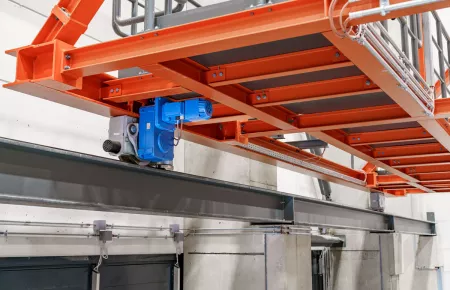
Stahlbau Wentz builds mobile extraction hood for fire tests
A special task for the Demag modular drive system
Flue gases “under the hood”
Company
Where other steel construction companies reach their limits, the specialists at Stahl-Projektbau Wentz GmbH come to the fore. Founded in Goslar in 2005, the company designs and builds pipeline bridges, support substructures and crane runway installations, among other things. The company's portfolio includes complete industrial buildings as well as test benches and process plants.
Wentz specialises in special steel constructions, including for research facilities. One example is individually designed radiation protection booths as enclosures for material testing systems and electron accelerators, among other things. Another very “exotic” example is the extraction system described here for an institute that carries out fire tests on building materials and components.
Requirement
How do building materials behave in the event of fire? And how can the fire risk of new and innovative building materials, e.g. from renewable raw materials, firstly be assessed and secondly minimised? A research facility in Braunschweig is investigating these questions and has set up a new experimental workshop for large-scale fire tests for this purpose.
The task of Stahlbau Wentz was to construct a movable 12 x 12 metre extractor hood in this workshop, which extracts all smoke gases generated by several open test benches and supplies them to a flue gas cleaning system. This places high demands on the materials handling components of the extractor hood, which must ensure reliable positioning of the extractor hood weighing several tonnes within a broad temperature range.
Solution
A crane runway was installed in the workshop on which a bridge made of a sectional steel structure travels. This positions the extractor hood above the relevant fire test. A raised bridge design was selected here to save on the overall height.
The entire unit consisting of bridge and steel extractor hood weighs 70 tonnes. It is precisely positioned on the craneway with a total of four Demag wheel blocks from the DRS 315 range. The wheel blocks are all equipped with flanges on both sides for reliable travel even in a broad temperature range of -20 to +70 degrees during the experiments. Two Demag ADE60TD ZBA80 offset geared brake motors transfer their power of 0.62 KW to the four wheel blocks. The offset gearbox design saves installation space. The drive concept is rounded off by a Demag Dedrive Compact frequency inverter, which moves the huge "extractor hood" continuously along the crane runway.
Special features
Demag DRS travel wheels with flanges on both sides ensure precise travel on one of the two crane runways. Both drives are controlled via a common Dedrive Compact frequency inverter. Synchronised control is thus guaranteed with minimal effort. Signals are evaluated by a Demag SCU safety control unit, which can achieve Performance Level 3 (EN ISO 13849) and SIL Level 2 (IEC 61508). As the travel unit is relatively high up, it is conveniently controlled by personnel from the working level via a Demag DRC-MJ radio control system. The Demag drive solution can be used up to an ambient temperature of 70 oC, which means that there is no risk of failure caused by overheating during the fire tests.
Your Contact

Christoph Kreutzenbeck
Ruhrstrasse 28
58300 Wetter
Germany













